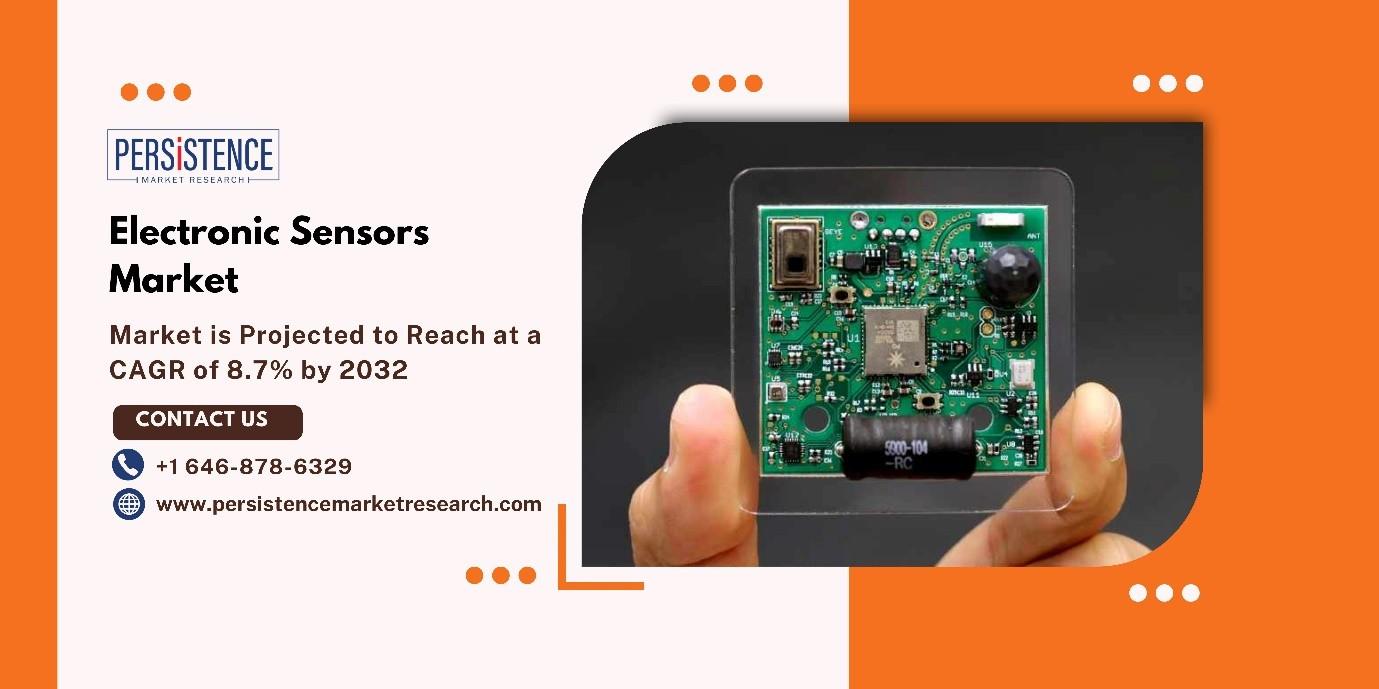
Electronic Sensors Market Introduction & Size Analysis:
The electronic sensors market is experiencing significant growth, driven by the increasing demand for automation, smart devices, and the Internet of Things (IoT) across various industries. These sensors, which convert physical parameters like temperature, pressure, and motion into electrical signals, are integral to modern technology. Applications range from automotive systems, consumer electronics, and industrial automation to healthcare devices and environmental monitoring. Advances in sensor technology, such as miniaturization and enhanced sensitivity, are also fueling market expansion. Additionally, the push towards smart cities and the adoption of autonomous vehicles are expected to further propel the demand for electronic sensors in the coming years. The Global Electronic Sensors Market size would reach US$ 52.6 billion in 2032. It stood at US$ 22.8 billion in 2022. The global market is likely to exhibit a CAGR of 8.7% during the forecast period.
The electronic sensors market is on a robust growth trajectory, driven by advancements in technology, increasing demand for smart devices, and the integration of sensors across various industries. Electronic sensors, which convert physical or environmental conditions into electrical signals, are pivotal in applications ranging from consumer electronics to industrial automation and healthcare. This blog explores the key growth opportunities in the electronic sensors market and highlights emerging trends and areas of potential expansion.
Key Growth Opportunities
Advancements in IoT (Internet of Things): The proliferation of IoT devices is a significant growth driver for the electronic sensors market. Sensors are integral to IoT systems, providing critical data for smart homes, smart cities, and industrial IoT applications. The demand for connected devices and smart solutions across various sectors is fueling the growth of sensor technologies.
Expansion of Wearable Technology: The rise of wearable technology, including fitness trackers, smartwatches, and health monitoring devices, is
creating substantial opportunities for electronic sensors. Wearables rely on sensors to monitor health metrics such as heart rate, blood pressure, and activity levels. Innovations in sensor technology are enhancing the accuracy and functionality of these devices.
Automotive Industry Innovations: The automotive industry is undergoing a significant transformation with the advent of autonomous vehicles, advanced driver-assistance systems (ADAS), and electric vehicles (EVs). Electronic sensors play a crucial role in vehicle safety, navigation, and performance monitoring. Opportunities abound in developing sensors for collision avoidance, lane departure warnings, and battery management systems.
Healthcare and Medical Devices: The healthcare sector is increasingly adopting electronic sensors for diagnostic and monitoring applications. Sensors are used in medical devices such as glucose monitors, imaging equipment, and wearable health trackers. The growing emphasis on personalized medicine and remote patient monitoring presents opportunities for developing advanced sensors with improved accuracy and reliability.
Industrial Automation and Smart Manufacturing: The move towards Industry 4.0 and smart manufacturing is driving demand for electronic sensors in industrial settings. Sensors are used for process control, equipment monitoring, and quality assurance. Opportunities exist in developing sensors that offer enhanced precision, durability, and real-time data analytics to optimize manufacturing processes.
Environmental Monitoring: Environmental monitoring and smart agriculture are emerging areas with significant sensor opportunities. Sensors are used to monitor air quality, water quality, and soil conditions. The increasing focus on environmental sustainability and the need for realtime data to address environmental challenges create growth potential for sensors designed for environmental applications.
Consumer Electronics: The consumer electronics sector continues to drive demand for electronic sensors, particularly in smartphones, tablets, and home automation products. Innovations in sensor technology, such as miniaturization and enhanced functionality, offer opportunities for new and improved consumer electronics applications.
Energy Management: Energy efficiency and management are critical concerns for both residential and commercial sectors. Electronic sensors play a role in smart grids, energy monitoring systems, and building automation. Opportunities exist in developing sensors that provide accurate measurements and insights to optimize energy consumption and support sustainable energy practices.
Request for Sample: https://www.persistencemarketresearch.com/samples/33369 Emerging Trends
Miniaturization and Integration: The trend towards miniaturization and integration of sensors into compact and multifunctional devices is creating new opportunities. Advances in micro-electromechanical systems (MEMS) and integration techniques enable the development of smaller, more efficient sensors that can be embedded in a wide range of products.
Advanced Materials and Technologies: The use of advanced materials, such as flexible electronics and nanomaterials, is enhancing sensor performance and capabilities. Innovations in sensor technologies, including biometric sensors, gas sensors, and optical sensors, are expanding their applications and functionality.
AI and Machine Learning Integration: The integration of artificial intelligence (AI) and machine learning with sensor technologies is transforming data analysis and decision-making processes. AI-powered sensors can provide more accurate predictions, anomaly detection, and adaptive responses, opening up new opportunities in various sectors.
5G and Connectivity: The rollout of 5G technology is expected to boost the electronic sensors market by enabling faster data transmission and improved connectivity for IoT devices. The increased bandwidth and low latency of 5G will support the development of more sophisticated sensor applications and real-time data analytics.
Sustainability and Eco-friendly Sensors: The growing emphasis on sustainability is driving the development of eco-friendly and energyefficient sensors. Manufacturers are focusing on creating sensors with reduced environmental impact, such as those made from recyclable materials or designed to consume less power.
Conclusion
The electronic sensors market is poised for significant growth, driven by advancements in technology, expanding applications across various industries, and increasing demand for smart and connected devices. The opportunities in this market are diverse, ranging from IoT and wearable technology to automotive innovations and environmental monitoring. As technology continues to evolve and new trends emerge, the electronic sensors market will offer numerous avenues for innovation and growth. Companies that capitalize on these opportunities and stay ahead of technological advancements will be wellpositioned to succeed in this dynamic and rapidly evolving market.
Follow Us: LinkedIn | Medium | Twitter
